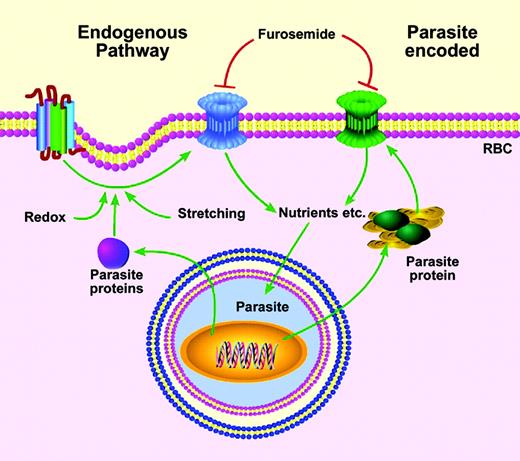Comment on Alkhalil et al, page 4279
A careful study suggests that the major nutrition uptake channel in the malaria parasite-infected erythrocyte plasma membrane is a product of the parasite genome rather than a modified erythrocyte molecule.
Having chosen to make its living off a red blood cell (RBC), the malaria parasite faces a significant challenge as to how it can convert this relatively inert bag of hemoglobin into a thriving, metabolically active entity. The first 15 to 18 hours after Plasmodium falciparum invades the RBC, called the ring stage, appear to be spent in devising means to meet this challenge. At this point, the permeability of the RBC plasma membrane is altered in a manner that now allows the exchange of anions, uncharged organic molecules, and some cations. This permits the necessary uptake of nutrients, resulting in the dramatic growth of the parasite. The so-called new permeability pathways established by P falciparum have been the subject of considerable investigations and some controversy. Initial work involved radioisotope flux and osmotic lysis of infected RBCs as a means to investigate these pathways, a key property being that these processes were inhibited by the diuretic furosemide.1 Desai et al2 used patch clamp methods on infected RBCs to identify an ion channel that they proposed to be involved in nutrient uptake. Subsequent to this finding, studies by other investigators3-5 have raised questions as to whether additional channels are present on the infected RBC and whether these channels arise through modifications of normal RBC proteins. As illustrated in the figure, the endogenous pathway of channel creation (left) could involve redox state of the RBC, stretching of the RBC membrane, and/or action of parasite products. The parasite-encoded pathway (right), on the other hand, would involve synthesis of the channel protein within the parasite, and its transport and assembly in the RBC membrane. Clearly, it is important to resolve these questions since a channel of this immense significance to the parasite begs to be used as a target for antimalarial drug development.
Possible origins of the nutrient channel in a parasite-infected RBC.
Possible origins of the nutrient channel in a parasite-infected RBC.
In this issue of Blood, Alkhalil and colleagues provide data that weigh in the favor of a parasite-encoded pathway for the nutrient channel. The authors examined furosemide sensitivity of 3 different properties ascribed to the channel, that is, radioisotope flux, osmotic lability in sorbitol, and patch clamp measurements. There was remarkable concordance of furosemide inhibition profiles in every one of these assays, providing strong support for the notion that a single entity is responsible for each of these altered parameters of infected RBCs. Alkhalil et al also examined the possibility that the channel may arise through modifications of a normal RBC protein, as suggested by other workers.3-5 Remarkably, they were unable to reproduce previous work that suggested the endogenous pathway for the channel. Explanation for this discrepancy may lie in technical details of patch clamping and electrophysiologic studies. Alkhalil et al scrupulously insisted on having a more than 100-GΩ seal for their patch clamps; anything less tight, they suggest, increases noise and may lead to artifacts. The channel has fairly low conductance with extremely rapid open/close timings, which may necessitate the higher seal resistance used by Alkhalil et al to gain optimal signal-to-noise ratio.
Critical evidence that the channel is parasite-encoded came from the observation that 2 geographically distant isolates of P falciparum exhibit channels on infected RBCs with distinguishable electrophysiologic properties when clamped at the membrane potential of +100 mV. This would suggest a polymorphism for this channel in these 2 parasite strains and argue against the modification of an endogenous RBC protein. Clearly, the argument of endogenous versus parasite-encoded origin of the channel will be settled unequivocally only when the gene encoding it has been cloned and expressed. Meanwhile, Alkhalil et al provide good circumstantial evidence for the parasite origin of the channel.


This feature is available to Subscribers Only
Sign In or Create an Account Close Modal